What does John Denver have to do with scuba diving? Nothing, really. Yet somehow, I ended up singing four hours of “Take Me Home, Country Roads” in the car as I made the trip from Durham, North Carolina, to Beckley, West Virginia, last week.
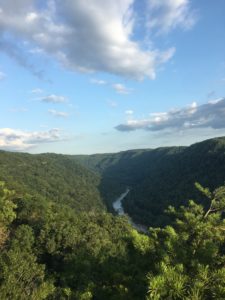
This was in part because I was curious about the Blue Ridge Mountains John sings about, but mostly because I was on my way to the 24th World Scout Jamboree. I wonder if John still would have considered it “Almost Heaven, West Virginia” if he made it to Summit Bechtel Reserve where the 44,000 scouts gathered for two weeks.
This is an international event that draws scouts from all over the world, and this year, more than 165 countries were represented. The main goal of the experience is to bring young people together to promote peace and the development of life skills and leadership.
The reserve covers over 10,000 acres of wilderness and has some of the largest outdoor-activity facilities in the country, including zip lines, climbing walls, and lakes. Additionally, there were multiple large, four-foot-deep inflatable pools in the center of all the booths at the Jamboree. The pools were outfitted with tons of BCDs, regulators, masks, scuba cylinders and an onsite compressor so the scouts could try scuba diving for the first time with a divemaster. I even had the chance to take a dive! (Can I log that?)
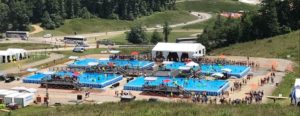
Large inflatable pools for scuba diving. Picture by Rhett Hendrickson. The DAN booth is located to the right in white tents. Campsite can be seen below the scuba center in the upper right corner.
Since the scuba diving experience is one of the largest events at the scout Jamboree, DAN sends staff members there every year to promote dive safety and coach scouts in CPR. The Jamboree is two weeks long; I attended the first week of the event accompanied by Jim Gunderson, Reilly Fogarty, and 4 CPR manikins to run our “CPR challenge” activity. Reilly, DAN research intern Andrea, and her husband, James ran the second week.
The goal of attending the Jamboree each year is to empower scouts to seek training and gain skills that can save lives in or out of the water. While we were not providing anyone with a full CPR class or official trianing, we did demonstrate 30 chest compressions and 2 rescue breaths. After the demos, we let the scouts have a try on the manikins for two minutes while we coached their technique.
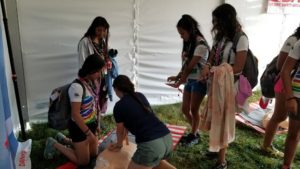
Demonstrating 30 chest compressions with two rescue breaths to a group from Chile.
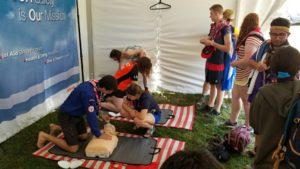
Coaching students as they practiced two minutes of CPR with a group from the United States.
It was interesting to see how many people were new to CPR versus those who already had training. I learned that many European countries teach CPR in school! We observed a wide range of skill levels, but everyone was enthusiastic about learning and improving.
Most scouts that attended our booth on the first day were English speakers, but we did meet one group from Argentina. I asked where they were from and if they were familiar with CPR. A girl in the front admitted that they did not know English and started to walk out of the tent. On the fly, I dug way back into my brain to recover something from the four years of Spanish classes I took in high school (with a wonderful teacher I might add), but it had been three years since I last spoke it. I did not want the scouts to walk out of our tent because they did not understand English, so I told them, “Uno momento! Yo hablo Español, pero no es muy bueno.” They laughed and agreed to come into the tent for a lesson.
It took a minute for my brain to switch into Spanish mode, but once it did, I was able to demonstrate CPR in Spanish to the group. Speaking Spanish may not be a skill I would put on a resume, but I was very surprised at my ability to successfully communicate with the group. That night, I went back to my hotel and studied up a few key words I didn’t know, like “compressions” (apparently, it’s just “compresiones”!), so I could be better prepared to speak with future groups.
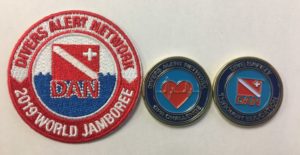
DAN patches and coins awarded to scouts who came through our tent and successfully completed 2 minutes of quality CPR.
Over the next few days at the Jamboree, I believe I spoke in more Spanish than I did English! Scouts were very patient with my efforts and they enjoyed teaching me new words. It was a humbling experience to ask scouts, “¿Inglés o Español?” and see the relief and excitement on their face knowing someone could cater to their own language. This allowed us to open our tent to a much broader audience, as I was able to coach scouts from Colombia, Peru, Chile, Spain, Argentina, and Mexico.
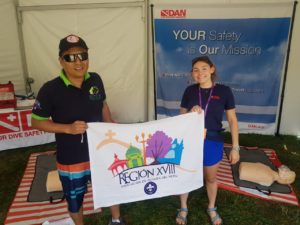
A new friend from Peru! I was very grateful for his patience with my Spanish speaking, and he really appreciated the introduction to CPR and one-on-one time I gave to coach him. We exchanged gifts, I gave him a DAN patch and coin and he gave me a bracelet from Peru!
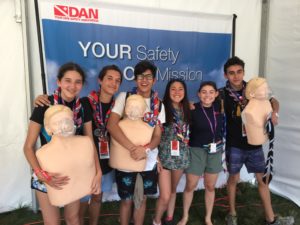
A fun group from Chile! They were excited to be taught in Spanish.
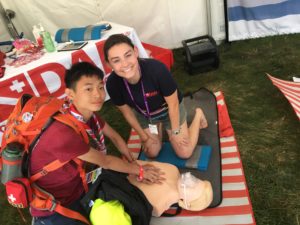
My new friend from Taiwan.
I had the pleasure of meeting many other people from all over the world at this event, including a young boy from Taiwan. He was so eager to learn and worked really hard to have a conversation in English while we waited for the rest of his troop to arrive. He had never seen a CPR manikin before, but after a bit of coaching, he was able to perform wonderful compressions. We also exchanged gifts, I gave him a DAN patch and coin and he gave me a scout logo that he had 3D printed!
Over the week that I was there, we had more than 1,200 scouts come through our booth. I am very thankful for this opportunity to share life-saving first aid with these intelligent youths. I hope that they continue their first aid education and seek official training, but for those who may not have this option in their home countries, the challenge gave them a great introduction to the process. While I hope no one has to experience a situation that warrants CPR, it is comforting to know these kids have a new tool in the box to help others.
As if the diving in the four-foot pool was not exciting enough, I also decided to attend a boat dive this weekend when I returned to North Carolina. This photo was taken on the wreck of The Hyde off the coast of Wrightsville Beach in Wilmington, NC—it was great to see a few adult sand tiger sharks! Thanks to Aquatic Safaris for the trip.

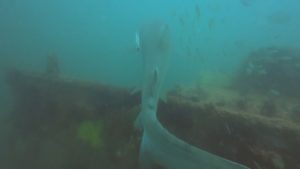
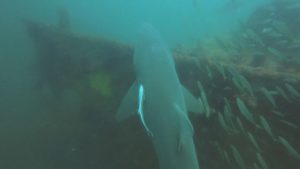



¡Excelente saber que usaste tu español para enseñar a tantas personas en el Jamboree! You have potentially saved many lives by reaching Spanish speaking learners of CPR, that is amazing!!! Thank you for doing that!
Warmly, your “proud_of_being_your_former_Spanish_high_school_teacher”
Connie Beuchat
Muchas gracias, Sra. B! Tu es la mejor profesora 🙂 Gracias para ensenarme!